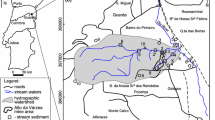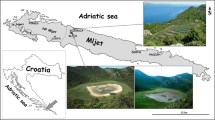Abstract
The Raibl mine (Cave del Predil village, northern Italy) belongs to the Pb–Zn minerogenetic district in the southeastern Alps, hosted in Middle Triassic carbonates. The drainage water quality reflects the high acid-buffering capacity of the carbonate rocks, which controls the mobility of most metals. In particular, Fe is non-detectable in solution, having formed hydrous-oxides precipitates. Molybdenum, Ni, Zn, Cd, Pb, and Tl are present, and the Pb, Tl, and Zn concentrations sometimes exceed the Italian regulatory thresholds. Thallium concentrations substantially exceed the 2 µg/L limit at some sampling stations, ranging between 12 and 30 µg/L in the mine drainage, and reaching 5 µg/L downstream of the mine site, despite strong dilution. The data indicate that Tl behaves almost conservatively and is not significantly scavenged by the Fe precipitates. The elevated Tl represents a potential risk for the stream ecosystem. Although Tl is not regulated in drinking water in Italy or the European Community, its distribution in natural waters may help to determine if health actions should be taken.
Zusammenfassung
Der Bergbau Raibl (Dorfgemeinde Cave del Predil, Norditalien) gehört zu dem minerogenetischen Pb–Zn-Distrikt in den südöstlichen Alpen; die Vererzung tritt in mitteltriadischen Karbonaten auf. Die Qualität der Abflußwässer spiegelt die hohe Säurepufferungskapazität der Karbonatgesteine wider, welche die Mobilität der meisten Metalle bestimmt. Besonders gelöstes Eisen ist nicht nachweisbar, weil es in Form wasserhaltiger Oxyde ausgefällt wird. Molybdän, Ni, Zn, Cd, Pb und Tl sind vorhanden; die Konzentration von Pb, Tl, und Zn überschreitet manchmal Schwellenwerte der italienischen Behörden. Die Konzentration von Thallium überschreitet die Grenze von 2 µg/L an manchen Probestellen wesentlich, mit Werten zwischen 12 und 30 µg/L in Bergbauausfluß, und nach starker Verdünnung talabwärts immer noch nahe 5 µg/L. Die Daten zeigen, daß sich Tl nahezu konservativ verhält und nicht in signifikantem Maß von Fe Präzipitaten fixiert wird. Erhöhtes Tl stellt für das Bachökosystem ein potentielles Risiko dar. Obwohl Tl in Trinkwasser weder in Italien noch in der Europäischen Union geregelt ist, kann seine Verteilung in natürlichen Gewässern bei der Entscheidung helfen, ob Gesundheitsaktionen erforderlich sind.
Resumen
La mina Raibl (villa Cave del Predil, norte Italia) pertenece al distrito minero-genético Pb–Zn en el sudeste de los Alpes, con carbonatos formados en el Triásico medio. La calidad del agua del drenaje refleja la alta capacidad buffer de las rocas carbonatadas, que controla la movilidad de la mayoría de los metales. En particular, Fe no es detectable en solución, habiendo formado precipitados de óxidos hidratados. Mo, Ni, Zn, Cd, Pb y Tl están presentes y las concentraciones de Pb, Tl y Zn a veces excede los niveles regulatorios italianos. Las concentraciones de talio exceden significativamente el límite de 2 µg/L en las estaciones de muestreo, y ubicadas entre 12 y 30 µg/L en el drenaje de minas y alcanzando 5 µg/L corriente abajo en el sitio de la mina, a pesar de una fuerte dilución. Los datos indican que el Tl se conserva y no es significativamente depurado por los precipitados de Fe. La elevada concentración de Tl representa un riesgo potencial para el ecosistema de las corrientes. Aunque el Tl no está regulado en el agua de bebida de Italia o de la Comunidad Europea, su distribución en aguas naturales puede ayudar a determinar si acciones preservativas de la salud deben ser tomadas.
摘要
莱贝(Raibl)矿(意大利北部的卡韦-德尔普雷迪尔村)位于阿尔卑斯山脉东南部铅锌矿成矿带,铅锌矿赋存于中三叠统碳酸盐岩之中。莱贝(Raibl)矿山废水的水质特征反映出碳酸盐岩具有较强的酸缓冲能力,该缓冲作用控制着多数金属离子的活性。由于铁离子水合氧化物的沉淀作用,废水溶液未检测出铁。溶液检出金属包括钼、镍、锌、镉、铅和铊,而且铅、铊和锌浓度有时已超出意大利规定的临界值。一些取样站水样的铊浓度已经远远超过2 µg/L界限;即使经过强烈稀释,矿山废水的铊浓度仍高达12 µg/L~30 µg/L,矿山下游河流水样的铊浓度达5 µg/L。以上测试数据证明铊元素较稳定,未被Fe沉淀物净化。水样中高浓度铊对河流生态系统产生潜在危险。虽然意大利及欧盟未对饮用水中铊浓度提出明确要求,但是铊在天然水体中的分布规律有助于我们决定是否应该进一步采取健康保护措施。





Similar content being viewed by others
References
Alderton DHM, Serafimovski T, Mullen B, Fairall K, James S (2005) The chemistry of waters associated with metal mining in Macedonia. Mine Water Environ 24:139–149
Allison JD, Brown DS, Novo-Gradac KJ (1991) MINTEQA2/PRODEFA2, a geochemical assessment model for environmental systems. U.S. EPA report 600/3-91/021, Washington DC
ATSDR (2014) Agency for toxic substances and disease registry. Health Consultation, Utah Dept of Health, http://www.atsdr.cdc.gov/HAC/pha/TraverseMountainHC/Traverse_Mountain_HC_PC_07-07-2014.pdf
Bidoglio G, Gibson PN, O’Gorman M, Roberts KJ (1993) X-ray adsorption spectroscopy investigation of surface redox transformations of thallium and chromium on colloidal mineral oxides. Geochim Cosmochim Acta 57:2389–2395
Blattner P, Lassey KR (1989) Stable-isotope exchange fronts, Damköler numbers and fluid to rock ratios. Chem Geol 78:381–392
Brigo L, Omenetto P (1979) The lead and zinc ores of the Raibl (Cave del Predil-northern Italy) Zone: new metallogenic data. Verh Geol Bundesaust 3:241–247
Brigo L, Kostelka L, Omenetto P, Schneider HJ, Schroll E, Schulz O, Strucl I (1977) Comparative reflections on four Alpine Pb-Zn deposits. In: Klemm DD, Schneider HJ (eds) Time- and stratabound ore deposits. Springer, Berlin, pp 273–293
Cerny L (1989) Current prospecting strategy for carbonate-hosted Pb–Zn mineralizations at Bleiberg-Kreuth (Austria). Econ Geol 84:1430–1435
Cidu R (2011) Mobility of aqueous contaminants at abandoned mining sites: insights from case studies in Sardinia with implications for remediation. Environ Earth Sci 64:503–512. doi:10.1007/s12665-010-0874-y
Cidu R, Dadea C, Desogus P, Fanfani L, Manca PP, Orrù G (2012) Assessment of environmental hazards at abandoned mining sites: a case study in Sardinia, Italy. Appl Geochem 27:1795–1806
Ebner F, Cerny I, Eichhorn R, Götzinger M, Paar WH, Prochaska W, Weber L (2000) Mineral resources in the Eastern Alps and adjoining areas. Mitt Österr Geol G 92:157–184
Fellet G, Pošćić F, Casolo V, Marchiol L (2012) Metallophytes and thallium hyperaccumulation at the former Raibl lead/zinc mining site (Julian Alps, Italy). Plant Biosyst 146:1023–1036
Foley NK (2002) Environmental geochemistry of platform carbonate-hosted sulfide deposits. In: Seal RR, Foley NK (eds) Progress on geoenvironmental models for selected mineral deposit types. USGS OFR 02-195, Denver CO, USA
Jacobson AR, McBride MB, Baveye P, Steenhuis TS (2005) Environmental factors determining the trace-level sorption of silver and thallium to soils. Sci Total Environ 345:191–205
Jambor JL, Blowes DW, Ritchie AIM (eds) (2003) Environmental aspects of mine wastes. Mineralogical Assoc of Canada Short Course Series vol 31, ISBN-13:978-0921294313
Kaplan DI, Mattigod SV (1998) Aqueous geochemistry of thallium. In: Nriagu JO (ed) Thallium in the Environment. Wiley-Interscience, London, pp 15–29
Kelley KD, Leach DL, Johnson CA, Clark JL, Fayek M, Slack JF, Anderson VM, Ayuso LE, Ridley WI (2004) Textural, compositional and sulfur isotope variations of sulfide minerals in the Red Dog Zn–Pb–Ag deposits, Brooks Range, Alaska: implications for ore formation. Econ Geol 99:1509–1532
Koschinsky A, Hein JR (2003) Uptake of elements from seawater by ferromanganese crusts: solid-phase association and seawater speciation. Mar Geol 198:331–351
Law S, Turner A (2011) Thallium in the hydrosphere of south west England. Environ Poll 159:3484–3489
Leach DL, Viets JB, Foley-Ayuso N, Klein DP (1995) Mississippi valley-type Pb–Zn deposits. In: du Bray EA (ed) Preliminary compilation of descriptive geoenvironmental mineral deposit models. USGS OFR 95-831:234–243
Leach DL, Sangster DF, Kelley KD, Large RR, Garven G, Allen CR, Gutzmer J and Walters S (2005) Sediment-hosted lead-zinc deposits: a global perspective. Econ Geol 105:561–607. http://alaska.usgs.gov/staff/geology/bradley/pubs/2010_Leach_secular_Pb-Zn.pdf
Leach DL, Bradley DC, Huston D, Pisarevsky SA, Taylor RD, Gardoll SJ (2010) Sediment-hosted lead-zinc deposits in Earth history. Econ Geol 105:593–625
Lin T-S, Nriagu JO (1998) Revised hydrolysis constants for thallium(I) and thallium(III) and the environmental implications. J Air Waste Manage Assoc 48:151–156
Luoma SN, Rainbow PS (2008) Metal contamination in aquatic environments. Cambridge University Press, Cambridge
Martinez-Frías J (1991) Sulphide and sulphosalt mineralogy and paragenesis from the Sierra Almagrera veins, Betic Cordillera (SE Spain). Estudios Geol 47:271–279
Mulkey JP, Oehme FW (1993) A review of thallium toxicity. Vet Human Toxicol 35:445–453
Murao S, Itoh S (1992) High thallium content in Kuroko-type ore. J Geochem Explor 43:223–231
Nordstrom DK (1977) Thermochemical redox equilibria of ZoBell’s solution. Geochim Cosmochim Acta 41:1835–1841
Nordstrom DK (2011) Hydrogeochemical processes governing the origin, transport and fate of major and trace elements from mine wastes and mineralized rock to surface waters. Appl Geochem 26:1777–1791
Nriagu JO (1998) Thallium in the environment. Wiley, New York City
Parkhurst DL, Appelo AAJ (1999) User’s guide to PREEQC (version 2)—a computer program for speciation, batch-reaction, one dimensional transport, and inverse geochemical modeling. USGS, p 99-4259
Peter AL, Viraraghavan T (2005) Thallium: a review of public health and environmental concerns. Environ Int 31:493–501
Plumlee GS, Smith KS, Montour MR, Ficklin WH, Mosier EL (1999) Geologic controls on the composition of natural waters and mine waters draining diverse mineral-deposit types. In: Filipe LH, Plumlee GS (eds) The environmental geochemistry of mineral desposits: case studies and research topics. Rev Econ Geol 6B: 373–432
Sager M (1994) Thallium. Toxicol Environ Chem 45:11–32
Schroll E (1996) The Triassic carbonate-hosted Pb–Zn mineralization in the Alps (Europe). The metallogenetic position of Bleiberg type. In: Sangster DF (ed), Carbonate-hosted lead–zinc deposits. Soc Econ Geol Spec Publ 4: 182–194
Schroll E, Prochaska W (2004) Contribution to ore fluid chemistry of Bleiberg Pb–Zn deposit (Austria) and affiliated deposits. Geochim Cosmochim Acta Suppl, Abstracts, 13th V.M. Goldschmidt Conf, A306
Schroll E, Rantitsch G (2005) Sulfur isotope patterns from the Bleiberg deposits (eastern Alps) and their implications for genetically affiliated lead-zinc deposits. Mineral Petrol 85:1–18
Smith KS, Huyck HLO (1999) An overview of the abundance, relative mobility, bioavailability, and human toxicity of metals. In: Plumlee GS, Logsdon MJ (eds) The environmental geochemistry of mineral deposits: part A. Processes, techniques and health issues, Rev Econ Geol 6A: 29–70
Xiao T, Guha J, Boyle D, Liu C-Q, Zheng B, Wilson GC, Rouleau A, Chen J (2004) Naturally occurring thallium: a hidden geoenvironmental hazard? Environ Int 30:501–507
Acknowledgments
L. Zini helped during the field survey; A. Lutman and S. Pison are thanked for discussions. The authors also wish to thank one of the referees, whose critical comments and careful revision greatly improved the manuscript.
Author information
Authors and Affiliations
Corresponding author
Rights and permissions
About this article
Cite this article
Petrini, R., Cidu, R. & Slejko, F.F. Thallium Contamination in the Raibl Mine Site Stream Drainage System (Eastern Alps, Italy). Mine Water Environ 35, 55–63 (2016). https://doi.org/10.1007/s10230-015-0346-4
Received:
Accepted:
Published:
Issue Date:
DOI: https://doi.org/10.1007/s10230-015-0346-4




